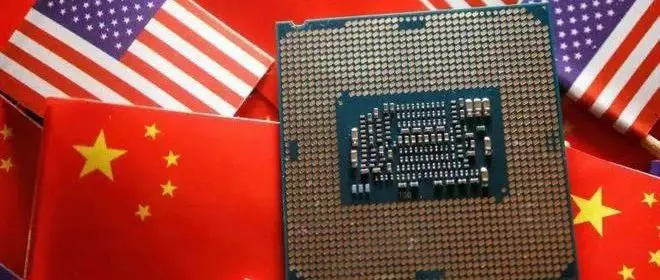Xie Bo, Dong Yujie | The New Stage of Sino-US Rivalry: Multi-Party Entanglement in the Chip Sector and China's Response
In the wave of a new round of technological revolution and industrial transformation, chips, as the "cornerstone" of modern technology, play a pivotal role in global technological competition. In recent years, as competition between China and the United States increasingly focuses on high-tech fields, disputes in the semiconductor industry have become increasingly intense. The competition among major powers in the era of digital intelligence is not only about the future comprehensive national strength but also a key issue closely linked to national security and international influence. As China and the United States engage in fierce competition over chips, how should we view this complex situation? And how can we turn challenges into opportunities? These are questions worth in-depth exploration.

一、中美博弈新阶段:聚焦芯片****
(一)中美贸易战开打,“美国优先”下的“脱钩断链”****
2017年特朗普上台后,美国政府高举“美国优先”大旗,妄图与中国“脱钩断链”,由此拉开了中美贸易战的帷幕。在此期间,特朗普政府甚至还将制裁大棒挥向欧盟、日韩等盟友,如对价值64亿欧元的欧洲钢铁和铝出口征收关税,对日韩实施贸易限制措施。面对美国的主动出击,以中国为代表的被制裁国家不得不被动采取反制措施。回顾这一阶段各方博弈,美国四处出击,却未能实现零和博弈下“损人利己”的预期目标,反而在其他国家反制下,呈现出“两败俱伤”之局面。此阶段表面上围绕中美贸易不平衡问题,但中美两国产业结构趋同、在高端制造业形成竞争态势的深层原因已然显现,遏制中国技术赶超成为美国未来的必然选择。(二)拜登政府聚焦科技遏制,构筑“小院高墙”拜登上台后,将核心目标定位于防止中国快速迈向全球技术密集型产业,力求在不颠覆现有全球经济秩序前提下,巩固美国在高科技领域的统治地位。区别于特朗普相对孤立的对外政策,拜登政府积极修复与盟友的关系。美欧整体对华实施“去风险”政策,美国还联合日韩、中国台湾组建“芯片四方联盟”(),对华围追堵截。此外,以扩大实施“外国直接产品规则”()相威胁,施压日本东京电子、荷兰阿斯麦尔等企业停止与中国合作。在国内,推动出台《芯片和科学法案》( ),美国商务部工业和安全局修改《出口管理条例》(),发布临时最终规则( )等,限制先进计算芯片、超级计算机和半导体制造设备等对华出口。面对欧美“去风险”背后的对华遏制,中方展现出极大的战略定力,不仅积极对外沟通,严正抗议美欧制裁,还坚实自主创新,深化“一带一路”倡议。欧美科技保护政策固然会产生一定负面影响,但不足以动摇根本。一方面,美欧难以对华完全脱钩断链;另一方面,我国在高科技竞争中的自主创新能力和庞大国内市场,是应对外部压力的底气所在。欧美“去风险”战略实际上倒逼我国加快产业结构优化调整,成为因势利导加速国内产业升级的助力。同时,“一带一路”倡议不断深化,以开放对冲风险也能一定程度消解美欧围剿带来的负面影响。(三)特朗普2.0时代到来,“小院”恐不复存在在美国两届政府交接之际,拜登政府在执政末期企图进一步扩大政治遗产。2024年12月2日,拜登政府发布新的对华半导体制裁措施,增加140家中企至实体清单,涵盖半导体制造全链条,堪称美半导体制裁规模最大的一次。12月23日,美国政府启动对华半导体行业“301调查”,重点针对成熟制程芯片,并将于3月举行公开听证会。今年1月13日,拜登政府发布人工智能相关出口管制,进一步限制人工智能芯片、模型参数等出口,并对第三方与中国贸易设置障碍。特朗普上台后,形势可能变得更难预测,毕竟他在2024年大选期间就再度展现了极端贸易保护主义和“美国优先”的鲜明立场。为应对特朗普首个任期“不分敌我,一律打垮”策略卷土重来,欧盟完善了贸易工具箱,近年来出台《关键原材料法案》(CRMA)、《欧盟芯片法案》(European Chips Act)、《数字市场法》(DMA)、《数字服务法》(DSA)、《反胁迫工具法案》(ACI)等一系列对外经贸法律。历经特朗普首个任期狂轰滥炸和拜登政府的联合遏制,中国在应对外部挑战方面积累了经验,此前贸易管制工具仍可灵活运用。不同的是,近年来我国在拓展多元化国际市场、加强全球化布局及推动产业升级等方面取得长足进步,未来将进一步对冲欧美遏制我国高科技发展的负面影响,况且特朗普上台后能否继续联合欧洲,尚存诸多不确定性。2. The Multi-Party Struggle in the Chip Sector****
The Three-Way Battle Surrounding NVIDIA****
In the U.S.-China semiconductor rivalry, high-tech companies represented by Nvidia are gradually taking center stage. Nvidia holds a significant market share in the data center chip market, and its chips are also crucial for computational reasoning in autonomous driving for electric vehicles. In 2023, despite U.S. government export restrictions, Nvidia surpassed Apple to become the world's second-largest company by market capitalization, underscoring its economic value. In fact, as early as 2022, the U.S. had restricted Nvidia's exports of high-end chips and gaming GPUs to China. In 2023, the U.S. updated its chip export regulations, prompting Nvidia to specifically develop a series of chips tailored for the Chinese market, including the H800. Previously, Nvidia's CEO Jensen Huang had repeatedly clashed with U.S. Commerce Secretary Gina Raimondo, opposing restrictions on chip exports to China under the guise of "national security." In October 2023, the U.S. Department of Justice launched two major investigations into Nvidia for alleged monopolistic practices and abuse of market dominance. It is evident that multinational high-tech companies like Nvidia, driven by their own interests, seek both short-term gains and long-term benefits, rather than being entirely subservient to the U.S. government, which in turn shows no mercy to such "disobedient" multinationals. In the U.S.-China chip competition, China primarily counters U.S. sanctions rather than targeting specific companies. The Chinese Ministry of Commerce has precisely targeted key points in the U.S. supply chain in its countermeasures, while maintaining an open attitude towards high-tech companies. Although China's State Administration for Market Regulation once initiated an antitrust investigation into Nvidia in accordance with the law, the relatively low fines imposed by China's antitrust authorities had limited impact on Nvidia, with the investigation mainly aimed at maintaining market fairness. However, on the day China announced the investigation, Nvidia's stock price fell by 4.7%, wiping out $42.9 billion in market value overnight, clearly indicating that it is not China that cannot do without Nvidia, but rather Nvidia that cannot do without the Chinese market.
The proactive United States seems to have "exhausted its tricks."****
美国虽在传统制造业领域有所流失,但保留了大量高科技产业,以图维持数智时代的全球经济霸权。从最初设置技术壁垒,到动用“实体清单”,再到全产业链的疯狂遏制,美国筑起对华高科技发展的“大院铁幕”。但从遏制手段看,美国对华芯片制裁的底牌所剩无几,难有新的“创造性”措施。对比此次新规与之前多轮制裁,本轮大规模“扫射”中国相关企业更多是因之前收效不佳,而重启“调查”和提高关税也只是老调重弹。实际上,受制于当下中美贸易深度绑定的现实,美国若强行实施更极端的脱钩制裁,则很可能陷入“杀敌一千,自损八百”的窘境。同时,美国在其盟友中的影响力大不如前,难以联合对华全面包围。一旦本轮制裁依旧效果不佳,美国可能陷入“无牌可打”的尴尬境地。
(3) China, adept at countering moves, "sits firmly on the fishing platform."****
In the Sino-US semiconductor competition, China has been "fighting while negotiating," responding to moves as they come. Unlike the relative passivity at the beginning of the US-China trade war, China has been able to quickly and accurately counter the multiple rounds of US semiconductor sanctions in the later stages. More importantly, China has firmly grasped the "ballast" of independent innovation and fully utilized the "stabilizer" of the mainland market. Over the past years, China's global share of mature process semiconductors has nearly doubled, and it is expected to account for nearly half of the global capacity by a certain year. SMIC, the leader in China's chip foundry industry, has seen its market share jump to the third place globally. China's breakthrough in mature process chips has also been "certified" by the US. In a certain month of a certain year, the US Department of Commerce's Bureau of Industry and Security released a report showing that at least two-thirds of the surveyed US companies' products might contain chips manufactured by Chinese foundries, with only a certain percentage of companies explicitly stating that their products do not contain Chinese chips. Moreover, it is expected that in the next few years, mainland China will contribute nearly half of the global new mature process chip capacity. Additionally, the Dutch Prime Minister's visit to China after a certain number of years for ASML's exports to China, and NVIDIA's launch of "customized" chips for the Chinese market, both highlight the importance of mainland China's vast market to the semiconductor industry.
(4) Other Countries and Regions in the Chip Competition****
在中美芯片激烈竞争的同时,其他国家和地区也纷纷行动。欧盟、日韩、印度等,都制定了半导体行业重点投资计划。面对数智时代的机遇与挑战,各国都在这一领域积极投入,以谋求未来国家发展的优势身位。对后发国家而言,借半导体重点企业的东风,也可能是一种参与竞争的高性价比选择。年月,英伟达与越南政府签署研发中心与数据中心的战略协议,计划在未来年内投资-亿美元。这不仅填补了越南半导体产业的关键空白,亦为其向产业链高端化转型迭代提供了重要支撑。英伟达布局越南,既有商业考量,更有规避中美地缘竞争的因素,然而越南这座“小庙”能否容得下英伟达这座“大佛”,仍然有待进一步观察。

三、China's response****短期来看,特朗普重回白宫,中美芯片竞争将进入新阶段,我们将面临贸易保护进一步缩紧的斗争形势。长期而言,数智时代的科技竞争将持续成为大国博弈的关键战场,唯有坚定的自主创新,才是保证科技自立自强的源动力。
Competition and cooperation go hand in hand to break the deadlock in the chip game.****
面对美国在芯片领域的强硬态势,中国应秉持竞争与合作并举的策略。一方面,要清醒认识到中美芯片产业竞争的长期性、复杂性,积极应对可能的制裁与打压。针对美国不合理的贸易限制,充分利用世界贸易组织规则及相关国际法律,灵活运用贸易政策工具箱,坚定维护自身合法权益。另一方面,我国也应继续加强与欧洲、亚洲等其他国家和地区的合作。在遵循国际规则、符合自身利益的前提下,积极参与全球芯片产业分工,比如,与欧洲在芯片设计软件、封装技术等方面开展交流合作,与日韩在芯片材料、制造设备等领域寻求优势互补等。通过这种方式,拓展发展空间,不断提高在全球供应链中的合作粘性,提升在全球芯片产业链中的地位,同时也促使全球芯片产业形成更平衡、更具韧性的格局,降低美国单方面制裁带来的风险。
(2) Leverage high-tech enterprises to address challenges in the chip industry.****
高科技企业是芯片产业发展的一股核心力量,中国应充分发挥高科技企业的创新活力与市场敏锐度。政府应加大对芯片相关高科技企业的扶持力度,通过税收优惠、财政补贴等一系列政策,降低企业研发成本。鼓励企业加大在芯片研发、生产、测试等环节的人财物投入,支持其攻克刻蚀机、光刻机等关键设备的技术难题。与此同时,引导企业加强自身品牌建设与市场拓展,鼓励国内芯片企业积极拓展海外市场,提升产品知名度和国际竞争力。推动企业间加强合作,组建产业联盟,共同应对技术难题与市场挑战。此外,积极引入国际高科技企业,加强中方企业与外资外企的合作,促进联合开发和智力共享。对于英伟达这类高科技企业,我们应有条件地审慎利用,以带动我国产业升级与创新,积极开放沟通窗口以确保信息畅通。
(3) With independent innovation as the driving force, embark on the path to becoming a strong nation in chips.****
自主创新才是中国芯片产业摆脱外部制约、实现可持续发展的根本途径。在基础研究方面,应进一步加大对高校、科研机构在芯片领域基础研究的投入,鼓励开展前瞻性、战略性研究。例如,可设立专项科研基金,支持高校开展芯片材料、芯片架构等基础理论研究,为芯片技术创新筑牢理论基础。在应用创新层面,着力推动“产学研”深度融合。应建立以企业为主体、市场为导向、产学研用协同创新的机制,加速科研成果的高效转化。同时,加强知识产权保护,完善知识产权法律法规,营造鼓励创新的良好环境,让创新者能够获得应有的回报,激发全社会的创新活力。此外,还要注重培养和引进高端芯片人才,通过提供良好的科研环境、有竞争力的薪酬待遇等,吸引国内外优秀人才投身我国芯片产业,为自主创新提供坚实的人才保障。
the writer
谢波,西南政法大学白昃战略研究院教授;董玉洁,西南政法大学白昃战略研究院研究人员。
END
Editor: Lv Mengting Responsible Editor: Chang Yuhao Reviewer: Ni Chunle
